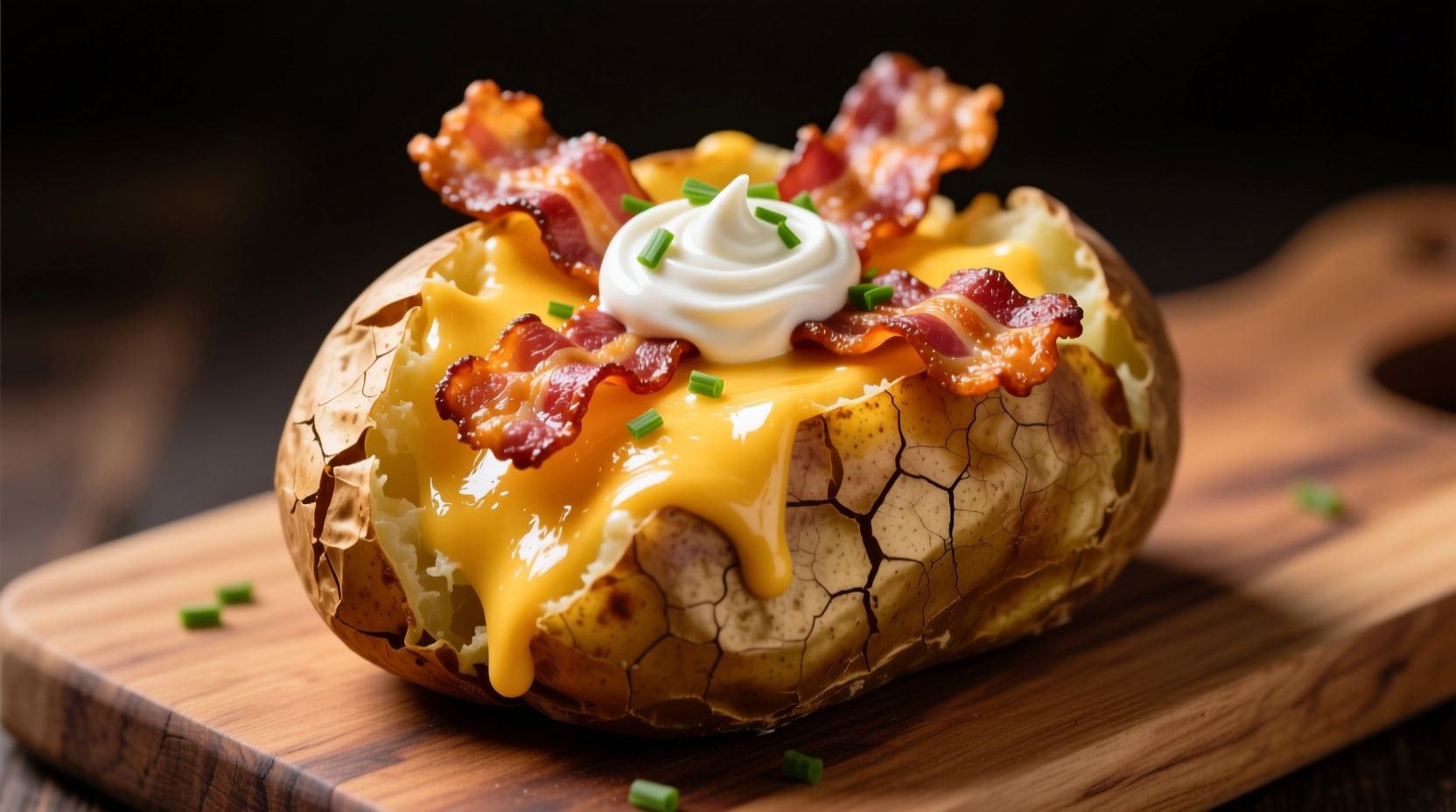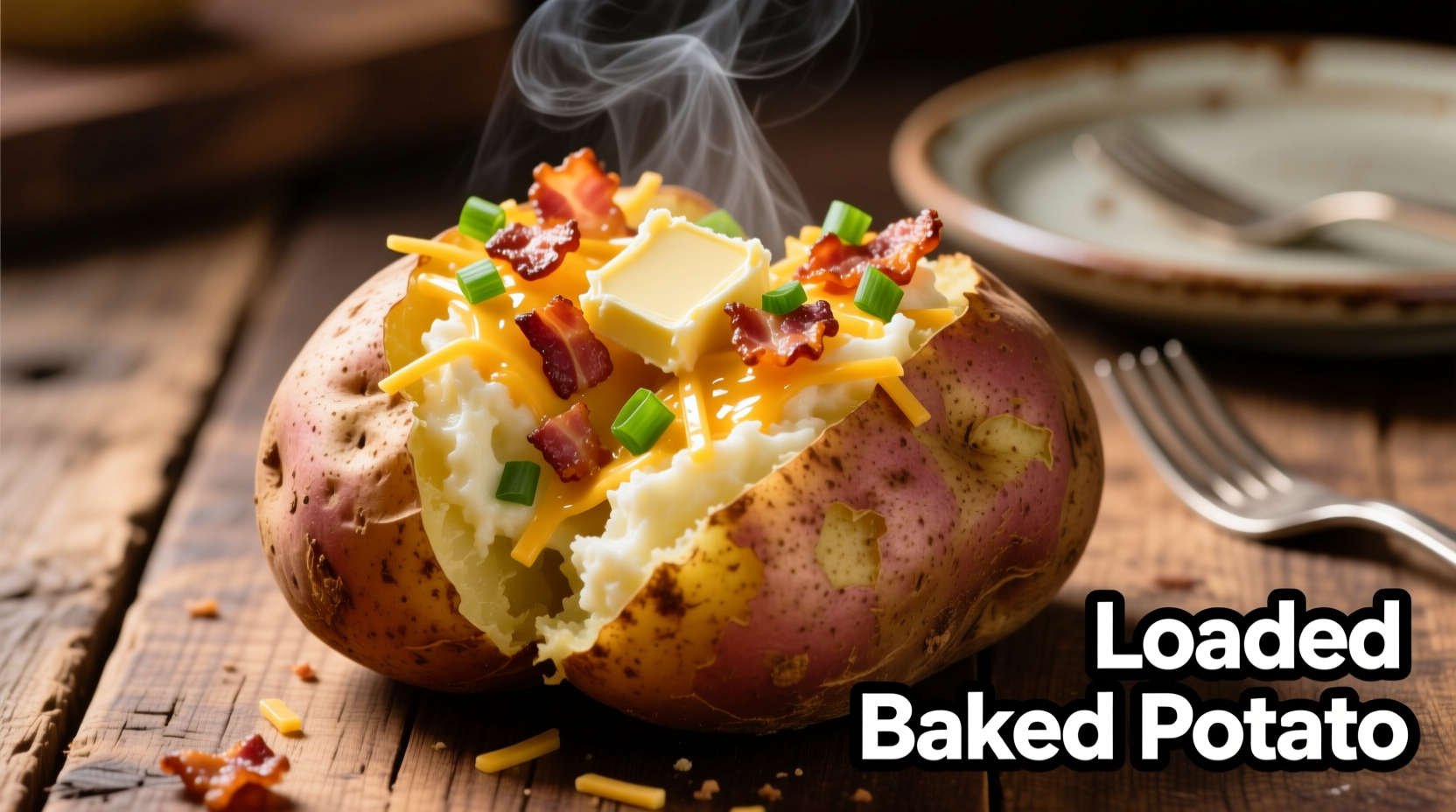The Essential Components of a Perfect Loaded Baked Potato
Creating an exceptional loaded baked potato starts with understanding its fundamental elements. Unlike basic baked potatoes, loaded versions combine complementary textures and flavors that elevate this humble side dish into a main course. The magic happens when crispy-skinned, fluffy-centered potatoes meet carefully balanced toppings that enhance rather than overwhelm the potato's natural earthiness.
According to the USDA FoodData Central, a medium russet potato provides 168 calories, 5 grams of fiber, and significant potassium—making it a nutrient-dense base when prepared properly. Professional kitchens achieve consistent results by controlling three critical factors: potato selection, baking technique, and topping temperature management.
Step-by-Step Preparation Guide
1. Potato Selection and Preparation
Choose uniform russet potatoes (8-10 ounces each) with smooth skins. Pierce each potato 6-8 times with a fork to prevent bursting. For crispier skins, rub with olive oil and coarse salt before baking. Never wrap potatoes in foil—that steams them rather than baking, resulting in soggy texture.
2. Optimal Baking Method
Bake directly on the oven rack at 400°F (200°C) for 55-65 minutes until internal temperature reaches 205°F (96°C). For time-sensitive situations, microwave for 5 minutes first, then finish in the oven for 20 minutes to achieve both speed and proper texture. The National Center for Home Food Preservation confirms this two-stage method preserves nutritional value while ensuring thorough cooking.
| Baking Method | Time Required | Texture Result | Best For |
|---|---|---|---|
| Oven-only | 55-65 minutes | Crispiest skin, fluffiest interior | Special occasions|
| Two-stage (microwave + oven) | 25 minutes | Nearly identical to oven-only | Weeknight dinners|
| Air fryer | 40-45 minutes | Extra-crispy skin | Small batches
Signature Topping Combinations
While classic loaded potatoes feature cheddar cheese, bacon, sour cream, and chives, creative variations can transform this dish for different occasions. The key is maintaining balance—each topping should complement rather than dominate.
Traditional Approach: Shred your own cheese (pre-shredded contains anti-caking agents that prevent smooth melting). Crumble bacon while still warm for maximum crispness. Add sour cream at serving temperature—adding it too early makes potatoes soggy. Fresh chives provide the perfect herbal note without overpowering.
Restaurant-Style Timeline Evolution:
Loaded baked potatoes evolved from simple diner fare to gourmet menu items through several key developments. In the 1970s, TGI Fridays popularized the concept as a standalone entrée. By the 1990s, chefs began experimenting with premium toppings like blue cheese and caramelized onions. Today's culinary trend focuses on globally-inspired variations while maintaining the dish's comforting essence.
Avoiding Common Mistakes
Even experienced cooks make these critical errors that compromise your loaded baked potato:
- Underseasoning the potato—salt the skin before baking and the interior after cutting
- Overloading toppings—maintain a 2:1 potato-to-toppings ratio for proper balance
- Using cold toppings—warm cheese sauce slightly and bring sour cream to room temperature
- Cutting too early—let potatoes rest 5 minutes after baking for optimal fluffiness
Contextual Serving Recommendations
Loaded baked potatoes excel in specific dining scenarios but have limitations. They're ideal as:
- Weeknight family dinners (ready in 30 minutes with two-stage method)
- Casual entertaining (easily customized for guests)
- Game day gatherings (make-ahead components)
They're less suitable for formal occasions or when serving more than 6 people due to individual preparation requirements. For larger groups, consider a baked potato bar setup with various topping stations.
Storage and Reheating Guidelines
Properly stored, loaded baked potatoes maintain quality for 3-4 days in the refrigerator. Separate components before storing—keep toppings in different containers from the baked potatoes. When reheating, place potato (without cold toppings) in a 350°F oven for 15-20 minutes until heated through, then add fresh toppings. The FDA Food Code recommends reheating cooked potatoes to 165°F internal temperature for food safety.

Customization Ideas for Every Palate
Transform your loaded baked potato with these creative variations:
- Mexican Style: Black beans, pico de gallo, avocado, and queso fresco
- Buffalo Chicken: Shredded chicken tossed in buffalo sauce, blue cheese crumbles, celery
- Breakfast Version: Scrambled eggs, breakfast sausage, and everything bagel seasoning
- Vegan Option: Cashew cheese sauce, tempeh bacon, and roasted garlic
Remember that successful customization maintains the essential potato-forward character while introducing complementary flavors. Start with small topping quantities and adjust to taste—overloading masks the potato's natural flavor that makes this dish special.
Frequently Asked Questions
Can I prepare loaded baked potatoes ahead of time?
Yes—bake and store potatoes in the refrigerator for up to 2 days. Reheat before adding toppings. For events, prepare components separately and assemble just before serving.
What's the best potato variety for loading?
Russet potatoes remain ideal due to their thick skins and fluffy interiors. Yukon Golds work for creamier texture but lack the structural integrity needed for heavy toppings.
How do I prevent soggy potatoes?
Avoid wrapping in foil during baking, don't add cold toppings too early, and ensure potatoes reach proper internal temperature (205°F) before loading.
Are loaded baked potatoes healthy?
They can be part of balanced meals when using moderate topping portions. Focus on vegetable-rich toppings and lean proteins while controlling cheese and sour cream quantities.











 浙公网安备
33010002000092号
浙公网安备
33010002000092号 浙B2-20120091-4
浙B2-20120091-4